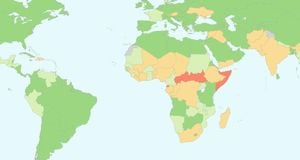Super Typhoon Man-yi is bearing down on the Philippines, prompting urgent evacuations and extensive preparations as the government braces for severe weather with life-threatening consequences.
With winds clocking up to 240 km/h (149 mph), this storm has rapidly intensified, designated as a super typhoon by the country’s national weather service, PAGASA. The super typhoon set its course toward the eastern part of the main island of Luzon, with landfall projected near Catanduanes province by Saturday night or early Sunday. The typhoon's local name is Pepito, previously thought to approach with peak intensity, but predictions have escalated due to its rapid strengthening.
On the ground, fears are mounting as storm surges may top 3 meters (about 10 feet) along the coast, particularly affecting the vulnerable central region of Bicol. Already, authorities have ordered the evacuation of approximately 255,000 individuals from high-risk coastal areas, making Man-yi potentially the sixth major storm to lash the nation within just one month. These efforts come after devastating impacts from Tropical Storm Trami, which had already caused substantial loss of life and infrastructure damage.
Local officials are not taking any chances. Civil defense administrators urge maximum preparedness as President Ferdinand Marcos Jr. has instructed all government agencies to prepare for the worst-case scenario. Preparations include setting up evacuation centers, where hundreds of thousands are seeking refuge. Reports indicate over 400 individuals crammed inside the provincial government building, with others moved to nearby gymnasiums.
The city of Naga has imposed curfews, hoping to keep residents safe indoors as the storm approaches. Amid this chaos, many families are ensuring their homes are adequately fortified, employing sandbags to shield windows and roofs against the incoming winds.
While the winds carry grave dangers, the heavy rainfall accompanying Man-yi is also of great concern. Torrential downpours forecasted for the central provinces threaten severe flooding and potentially deadly landslides, compounding the risks already posed by the storm’s high winds.
PAGASA has elevated its storm alert levels. Catanduanes has received the highest alert from the agency, with nearby provinces experiencing lesser warnings but still significant preparations set to account for possible impacts. With the typhoon approaching, the memory of the previous storm, which resulted in around 162 fatalities and numerous structures lost to floods and landslides, looms heavily on the minds of Filipinos.
Fatalities are not the only statistics haunting the authorities. Historically, the Philippines endures around 20 tropical storms on average yearly. This year has seen particularly harsh conditions, with four other storms swirling simultaneously across the Pacific Ocean for the first time since records started being kept by the Japan Meteorological Agency.
The collective anguish of residents facing yet another possible disaster underlines the country’s struggles with climate change and its propensity for destructive storms. How well they brace for and recover from such disasters remains uncertain, as many residents still find themselves without adequate resources or shelter.
With international assistance mechanisms ready to be activated, the country’s leadership closely watches both the storm’s track and the people’s safety. Emergency response plans are being fine-tuned as forecasts indicate another overwhelming natural event is imminent.
For many, the unrelenting pattern of disasters raises questions about preparedness and resilience. How will the Philippines adapt to this increasing frequency of severe weather events? What measures can citizens take, and how can the government support those most affected? These questions linger as Man-yi approaches, prompting not just immediate actions but long-term reflection on resilience and sustainability.



